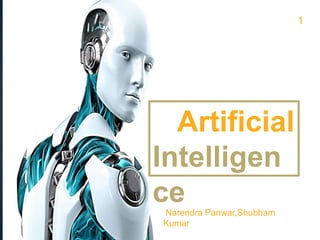
Artifical intelligence-NIT Kurukshetra
- 2. 3 Key Technologies • Steam Power • Iron Making • Textile Making Benefits • Mass Production • Cheaper costs • Faster travel • Freed people daily chores 2
- 3. Shift to electronic transfer of information / The Internet/Computing Revolution 3
- 4. Combination of machines with computers • Connecting machines with computers allows manufcture using blueprints. • Assembly robots can be reconfigured using computer codes 4
- 5. • Study of methods for building intelligent machines. Key AI Sub-disciplines Machine Vision (e.g. recognise objects ,3d reconstruction etc) Machine Learning(mathematical theory/algo. for learning ) Natural Language Processing(understanding meanings/syntax) Speech recognition & synthesis (convert voice to text) 5
- 6. What is Artificial Intelligence The theory and development of computer systems able to perform tasks normally requiring human intelligence, such as visual perception, speech recognition, decision- making, and translation between languages. 6
- 7. What is Artificial Intelligence In Simple, it’s the science and engineering of making intelligent machines , especially intelligent computer programs. 7
- 8. What is Artificial Intelligence It’s a composition of abilities like: 8
- 9. What is Artificial Intelligence It’s a composition of abilities like: LEARNING 9
- 10. What is Artificial Intelligence It’s a composition of abilities like: REASONIN 10
- 11. What is Artificial Intelligence It’s a composition of abilities like: PERCEIVIN 11
- 12. What is Artificial Intelligence It’s a composition of abilities like: KNOWLEDGE OF LANGUAGES 12
- 13. • Intelligence: “ the capacity to learn and solve problems” • Artificial Intelligence (AI): It is the intelligence of machines and robots and the branch of computer science that aims to create it the ability to solve problems. the ability to act rationally. 13
- 14. “machines will be capable , within twenty years, of doing any work a man can do”. Two years later MIT researcher Marvin Minsky predicted, “Within a generation … the problem of creating ‘Artificial Intelligence’ will substantially be solved”. 14
- 15. 50 60 70 80 90 00 10 1956 Dartmouth conference. 1981 Japanese Fifth Generation project launched as the Expert Systems age blossoms in the US. 1988 AI revenues peak at $1 billion. AI Winter begins. academic $ academic and routine 15
- 16. J. McCarthy, M. L. Minsky, N. Rochester, and C.E. Shannon. August 31, 1955. "We propose that a 2 month, 10 man study of artificial intelligence be carried out during the summer of 1956 at Dartmouth College in Hanover, New Hampshire. The study is to proceed on the basis of the conjecture that every aspect of learning or any other feature of intelligence can in principle be so precisely described that a machine can be 16
- 17. Artificial intelligence researchers have developed several specialized programming language for artificial intelligence which include Lisp,Prolog,Java,Phython,Planner, POP-101 etc. 17
- 18. Lisp is a family of computer programming languages with a long history. The name LISP derives from “List Processing”. Linked list are one of LISP languages’ major data structure and lisp source code is itself made of lists so lisp can manipulate code as a data structure. It is an important language for AI programming. Lisp programs define how to perform an 18
- 19. • Game Playing • Speech recognition • Understanding natural language • Robotics • Education • Expert System • General Problem Solving • Unmanned drone aircraft • Medical field like remote controlled surgical procedures • Many other Industrial uses(Robotic 19
- 20. Computer vision is an interdisciplinary field that deals with how computers can be made to gain high-level understanding from digital images or videos. Its tasks include methods for acquiring, processing, analyzing and understanding 20
- 21. A common example - Google photos 21
- 22. Automatic number plate recognition(ANPR) is a technology that uses optical character recognition on images to read vehicle number plate. The Police track all car movements around the country in real time. 22
- 23. 23
- 24. Machine learning is the subfield of computer science that gives computers the ability to learn without being explicitly programmed. It is closely related to computational statistics, which also focuses in prediction-making through the use of computers. 24
- 25. Dress length S I z e Indicate dress sold Indicate dress not sold Problem : Need to decide whether certain dress will sell or not ? 25
- 26. Dress length S I z e Indicate dress sold Indicate dress not sold Machine learning algorithm identify the region that can separate the two classes . Predicate whether this dress be sold or not.? 26
- 27. Ultimate goal : build machine that can ‘understand ‘ human language Speech understanding Speech recognition – convert speech to text Speech synthesis – convert text to speech Language understanding Understand the meaning of sentence one of the hardest problem in AI 27
- 28. Robots are the artificial agents acting in real world environment. They are aimed at manipulating the objects by perceiving, picking, moving, modifying the physical properties of object, destroying it. AI would be a recreation of the human thought process – a man-made machine with our intellectual abilities. The most common present applications of robots is o Assembly and finishing o Movement of materials/objects o Performing in hazardous conditions 28
- 29. (using current AI Technology) AI SYSTEM Partially replace manual work with an AI System Benefits – Higher efficiency lower cost 29
- 30. Till now , we have discussed in brief about artificial intelligence . We have discuss some of its principle, its application ,its achievement etc. The ultimate goal of institutions and scientists working on AI is to solve majority of the problem or to achieve the tasks which we humans directly can’t accomplish . It is for sure that development in this field of computer science will change the complete scenario of the 30
- 31. 31
- 32. 32